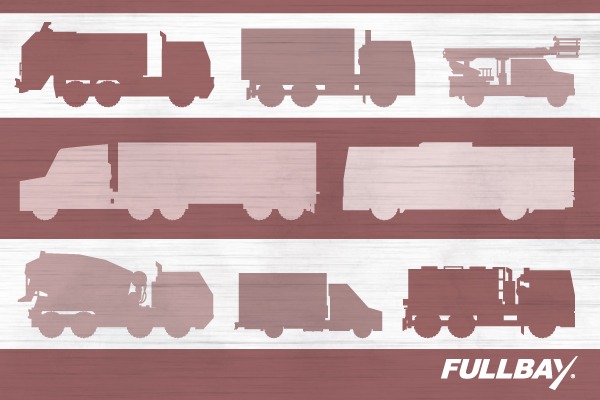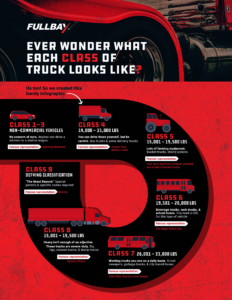Making Sense of Truck Classification

Show a truck to the average person off the street, and all they see is a truck. When a driver or fleet manager sees one however, their brains start computing, cataloging the vehicle into the proper class. How much does it weigh? What’s the payload designation? Is it a heavy-duty truck requiring a special license to drive it? All those elements factor into the truck classification, signifying what the vehicle is built to do.

Truck Classification Infographic – learn everything you need to know about classes 1 through 9! Click to view full size.
How Truck Classification Works
In a nutshell, truck classification looks at the Gross Vehicle Weight Rating or the GVWR. It’s how manufacturers label trucks based on government guidelines. The GVWR indicates the maximum truck weight plus what it’s able to carry fully loaded. That includes the truck’s own weight plus the fuel, cargo, passengers, and even the trailer tongue, according to the diesel website the TruckStop. Trailer classification regulates safety, but it’s also useful for commercial designation and when registering vehicles.
Why Does It Matter?
In short, a truck’s GVWR is also used to determine things like how long a truck can operate continuously, what kind of permits you need to obtain to operate it, and whether you need to stop at weigh stations.
Here are some of the items impacted by the GVWR:
Permit requirements
If you’re hauling oversized equipment, you may need certain identifying marks (like signs) and permits to proceed.
DOT number regulations
If your vehicle is more than 10,001 pounds, it must have a Department of Transportation (DOT) number on both sides, not just one.
Maintenance needs
A repair shop or mobile technician isn’t going to be able to properly prepare for you if they don’t have the right information about your vehicle. If you say “Class 7,” they’ll know they need certain tools available, or space set aside in a bay.
License levels
It’s not one-license-fits-all for big trucks! A driver needs a CDL to operate anything over 26,000 pounds, but those licensing regulations are further divided into Class A (26,001 pounds or more, provided that you’re towing something over 10,000 pounds); Class B (26,001 pounds or more, towing a vehicle that weighs up to 10,000 pounds); or Class C (passenger transport or hazardous materials).
Hours-of-service (HOS) laws
If you’re driving a vehicle that weighs more than 10,001 pounds, FMCSA’s Interstate Truck Driver’s Hours of Service will apply to you.
Weigh station guidelines
If your truck is over a certain amount of weight, you are required to stop at weigh stations for a check.
The Categories
Categories begin with Class 1 and run through Class 9. Considered “light,” Classes 1 through 3 typically cover non-commercial vehicles. Minivans, cargo vans, SUVs, and pickup trucks, for example.
Medium Trucks
Truck classification for medium trucks involves Classes 4, 5, and 6. That’s where commercial trucks start to show up. Classes 4 and 5 include some full-size trucks used non-commercially. Still, most of the medium-class vehicles are made and used for commercial purposes.

Class 4—The GVWRs for this class range between 14,001 and 16,000 pounds. This class is where you’ll find the Ford E-450 passenger van and F-450 super duty pickup. Box trucks typically fall into this truck classification. So do some large walk-in and city delivery trucks.

Class 5—This class covers trucks with GVWRs from 16,001 to 19,500 pounds. There are still a few vehicles in this class that straddle the line between non-commercial and commercial use such as Ford’s F-550. However, this class is where more commercial vehicles emerge. It includes larger walk-ins and delivery trucks, as well as bucket trucks or cherry pickers.

Class 6—With GVWRs between 19,501 and 26,000, this class covers medium-duty commercial trucks. It’s the category for single-axle and beverage trucks, along with rack trucks. School buses are also in Class 6. What’s more, this is the class where the need for Commercial Driver’s Licenses starts. The requirement depends on the individual vehicle weight. Driving vehicles weighing more than 26,000 requires a CDL. It applies to combined weight, too, like if you’re towing trailers or other vehicles that weigh more than 10,000 pounds.
Heavy-Duty Truck Classification
Heavy-duty truck classification covers Classes 7 and 8. It’s where you’ll find the big rigs and other commercial vehicles.

Class 7—The GVWRs for this class range between 26,001 and 33,000 pounds and usually have three axles or more. This class covers city vehicles such as street sweepers, garbage trucks, and city transit buses. Furniture trucks and smaller semis fit into this category as well.

Class 8—This class applies to most of the rest. It’s for the really huge trucks with GVWRs over 33,001. The vehicles in this class are more than heavy duty. Typically called “severe duty,” Class 8 applies to cement trucks and dump trucks. It’s also where you’ll find the big rigs like Freightliners, Kenworths, and Peterbilts.
Vehicles That Defy Truck Classification

The gross vehicle weight limit for Class 8 appears open-ended, but it’s not. The maximum is set on a case-by-case basis using the Federal Bridge Gross Weight Formula. Using this equation, it’s possible for longer, heavier loads to safely travel interstate highways. A longer 18-wheeler, for example, can weigh as much as 80,000 pounds.
What’s more, many states allow exceptions to the GVWR and per-axel limits determined by the FBGW Formula. They’re considered “oversized loads.” Trucks fitting unique circumstances are required to obtain special permits. Plus, they must travel along specially designated routes.
If you would like to download the above infographic–you can do that here!

